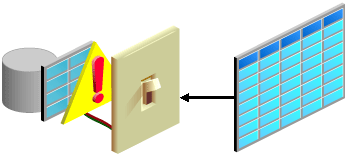Using Triggers

While working with a database application, you may want to add programmatic
functionality that executes when specific operations occur in the database.
For example, there may be typical scenarios such as the following:
- Example 1: You may want to insert data into a table.
You find that the new data is inconsistent with the existing data in
the table. You may want the system to raise an error that will cause the
transaction to be rolled back.
- Example 2: You may want the system to record information such as the timing and the details of the user modifying data in a table.
Triggers help the user deal with these and other complex situations. A trigger is a PL/SQL block or a PL/SQL procedure
associated with a table, view, schema, or database. Triggers are used to
ensure data integrity by checking on data in a consistent fashion. A trigger
executes implicitly whenever a particular event takes place.
- Improved
data security
Triggers provide enhanced and complex security checks, auditing.
- Improved
data integrity
Triggers enforce dynamic data integrity and complex referential integrity constraints. Triggers ensure that related operations are performed together implicitly.
You will watch Sheila create and manage triggers.
